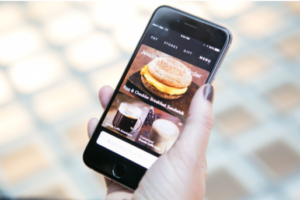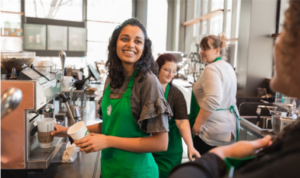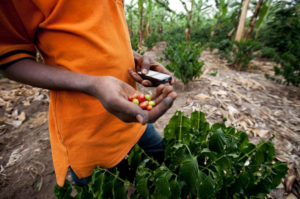Walk into a Starbucks store anywhere in the world and you’ll encounter a similar sight: coffee beans grinding, espresso shots being pulled and customers talking to baristas while their coffee order is hand-crafted.
The process may look like a simple everyday scene, but it is carefully orchestrated to serve Starbucks’ more than 100 million weekly customers. With the help of Microsoft, Starbucks is creating an even more personal, seamless customer experience in its stores by implementing advanced technologies, ranging from cloud computing to blockchain.
“Everything we do in technology is centered around the customer connection in the store, the human connection, one person, one cup, one neighborhood at a time,” says Gerri Martin-Flickinger, Starbucks executive vice president and chief technology officer.
Making recommendations more relevant with reinforcement learning 
Starbucks has been using reinforcement learning technology — a type of machine learning in which a system learns to make decisions in complex, unpredictable environments based upon external feedback — to provide a more personalized experience for customers who use the Starbucks® mobile app.
Within the app, customers receive tailor-made order suggestions generated via a reinforcement learning platform that is built and hosted in Microsoft Azure. Through this technology and the work of Starbucks data scientists, 16 million active Starbucks® Rewards members now receive thoughtful recommendations from the app for food and drinks based on local store inventory, popular selections, weather, time of day, community preferences and previous orders.
“Starbucks is an experience,” says Martin-Flickinger. “And it’s centered around that customer connection in the store, the human connection, one person, one cup, one neighborhood at a time. I think that mission is so critical to how technology has to show up for us.”
Now, Starbucks is looking to expand this technology to the drive-thru experience.
Implementing IoT to deliver a smooth coffee experience
Each Starbucks store has more than a dozen pieces of equipment, from coffee machines to grinders and blenders, that must be operational around 16 hours a day. A glitch in any of those devices can mean service calls that rack up repair costs. More significantly, equipment problems can potentially interfere with Starbucks’ primary goal of providing a consistently high-quality customer experience.
 “Any time we can create additional moments of connection between our partners and customers, we want to explore and activate,” says Natarajan “Venkat” Venkatakrishnan, vice president of global equipment for Starbucks. “Our machines are what allow our partners to create that special beverage, and ensuring they are working properly is critical.”
“Any time we can create additional moments of connection between our partners and customers, we want to explore and activate,” says Natarajan “Venkat” Venkatakrishnan, vice president of global equipment for Starbucks. “Our machines are what allow our partners to create that special beverage, and ensuring they are working properly is critical.”
To reduce disruptions to that experience and securely connect its devices in the cloud, Starbucks is partnering with Microsoft to deploy Azure Sphere, designed to secure the coming wave of connected internet of things (IoT) devices across its store equipment.
Starbucks partners are able to spend more time hand-crafting the perfect beverage and less time on machine maintenance thanks to cloud-connected devices.
The IoT-enabled machines collect more than a dozen data points for every shot of espresso pulled, from the type of beans used to the coffee’s temperature and water quality, generating more than 5 megabytes of data in an eight-hour shift. Microsoft worked with Starbucks to develop an external device called a guardian module to connect the company’s various pieces of equipment to Azure Sphere in order to securely aggregate data and proactively identify problems with the machines.
The solution will also enable Starbucks to send new coffee recipes directly to machines, which it has previously done by manually delivering the recipes to stores via thumb drive multiple times a year. Now the recipes can be delivered securely from the cloud to Azure Sphere-enabled devices at the click of a button.
“Think about the complexity — we have to get to 30,000 stores in nearly 80 markets to update those recipes,” says Jeff Wile, senior vice president of retail and core technology services for Starbucks Technology. “That recipe push is a huge part of the cost savings and the justification for doing this.”
The overarching goal with Azure Sphere, Wile says, is to shift from reactive maintenance to a predictive approach that heads off issues before they happen. Longer term, the company envisions leveraging Azure Sphere for additional uses such as managing inventory and ordering supplies, and will encourage suppliers of its devices to build the solution into future versions of their products.
Using blockchain to share coffee’s journey with customers
Starbucks is also innovating ways to trace the journey that its coffee makes from farm to cup — and to connect the people who drink it with the people who grow it. The company is developing a feature for its mobile app that shows customers information about where their packaged coffee comes from, from where it was grown and what Starbucks is doing to support farmers in those locations, to where and when it was roasted, tasting notes and more.
For Starbucks, which has long been committed to ethical sourcing, knowing where its coffee comes from is not new. Last year alone, Starbucks worked with more than 380,000 coffee farms. However, digital, real-time traceability will allow customers to know more about their coffee beans. Perhaps even more important and differentiating are the potential benefits for coffee farmers to know where their beans go after they sell them.

“While high-quality, handcrafted beverages are so important, it’s the stories, the people, the connections, the humanity behind that coffee that inspires everything we do,” says Michelle Burns, Starbucks senior vice president of Global Coffee & Tea. “This kind of transparency offers customers the chance to see that the coffee they enjoy from us is the result of many people caring deeply.”
Starbucks previewed digital traceability for shareholders at its annual meeting in March. Eventually, customers will be able to use the Starbucks mobile app to trace the journey of their Starbucks packaged coffee.
“What we’re still working on is interviewing coffee farmers in Costa Rica, Colombia and Rwanda, learning more about their stories, their knowledge and their needs in order to determine how digital traceability can best benefit them,” says Burns. “We’re forging new ground here, so we’re excited to report more in the coming months.”
